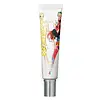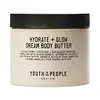What's inside
What's inside
 Key Ingredients
Key Ingredients

 Benefits
Benefits

 Concerns
Concerns

 Ingredients Side-by-side
Ingredients Side-by-side

Water
Skin ConditioningButylene Glycol
HumectantEthylhexyl Methoxycinnamate
UV AbsorberDiethylhexyl Succinate
EmollientDiethylamino Hydroxybenzoyl Hexyl Benzoate
UV FilterPentylene Glycol
Skin ConditioningVp/Eicosene Copolymer
Honey
HumectantSodium Hyaluronate
HumectantHydrolyzed Collagen
EmollientHydrolyzed Elastin
EmollientHydrolyzed Mango Juice Extract
Skin ConditioningHydrolyzed Garcinia Mangostana Fruit Extract
Skin ConditioningHydrolyzed Annona Cherimola Fruit Extract
AntioxidantOak Root Extract
Skin ConditioningZea Mays Leaf Extract
Skin ConditioningCoffea Arabica Seed Extract
MaskingCeramide NP
Skin ConditioningRetinol
Skin ConditioningAcetyl Glucosamine
Skin ConditioningOryza Sativa Seed Oil
Skin ConditioningCassia Senna Leaf Extract
Skin ConditioningActinidia Chinensis Fruit Extract
EmollientYeast Extract
Skin ConditioningAlteromonas Ferment Extract
Skin ConditioningCerium Oxide
Vitis Vinifera Seed Extract
AntimicrobialCaffeine
Skin ConditioningCarnitine
CleansingLactic Acid
BufferingGlucosyl Hesperidin
HumectantChlorella Vulgaris Extract
Skin ConditioningKunzea Pomifera Fruit Extract
Skin ConditioningChrysanthemum Indicum Extract
AntioxidantZea Mays Oil
EmulsifyingPantetheine Sulfonate
Skin ConditioningMicrocrystalline Cellulose
AbsorbentMaltodextrin
AbsorbentTocopherol
AntioxidantPlatinum
AntimicrobialSorbitol
HumectantGlycerin
HumectantSodium Ascorbyl Phosphate
AntioxidantMenthol
MaskingEthylhexylglycerin
Skin ConditioningGlyceryl Stearate
EmollientSilica
AbrasiveTitanium Dioxide
Cosmetic ColorantOctocrylene
UV AbsorberMethyl Methacrylate Crosspolymer
Bis-Ethylhexyloxyphenol Methoxyphenyl Triazine
Skin ConditioningHydroxyethyl Acrylate/Sodium Acryloyldimethyl Taurate Copolymer
Emulsion StabilisingAcrylates/C10-30 Alkyl Acrylate Crosspolymer
Emulsion StabilisingAmmonium Acryloyldimethyltaurate/Vp Copolymer
T-Butyl Alcohol
PerfumingSodium Hydroxide
BufferingPentetic Acid
CI 77492
Cosmetic ColorantAlumina
AbrasivePEG-60 Almond Glycerides
EmulsifyingCapric Acid
CleansingCetyl Hydroxyethylcellulose
Emulsion StabilisingAlcohol Denat.
AntimicrobialPolysorbate 60
EmulsifyingMica
Cosmetic ColorantPhenoxyethanol
PreservativeDiamond Powder
AbrasiveParfum
MaskingWater, Butylene Glycol, Ethylhexyl Methoxycinnamate, Diethylhexyl Succinate, Diethylamino Hydroxybenzoyl Hexyl Benzoate, Pentylene Glycol, Vp/Eicosene Copolymer, Honey, Sodium Hyaluronate, Hydrolyzed Collagen, Hydrolyzed Elastin, Hydrolyzed Mango Juice Extract, Hydrolyzed Garcinia Mangostana Fruit Extract, Hydrolyzed Annona Cherimola Fruit Extract, Oak Root Extract, Zea Mays Leaf Extract, Coffea Arabica Seed Extract, Ceramide NP, Retinol, Acetyl Glucosamine, Oryza Sativa Seed Oil, Cassia Senna Leaf Extract, Actinidia Chinensis Fruit Extract, Yeast Extract, Alteromonas Ferment Extract, Cerium Oxide, Vitis Vinifera Seed Extract, Caffeine, Carnitine, Lactic Acid, Glucosyl Hesperidin, Chlorella Vulgaris Extract, Kunzea Pomifera Fruit Extract, Chrysanthemum Indicum Extract, Zea Mays Oil, Pantetheine Sulfonate, Microcrystalline Cellulose, Maltodextrin, Tocopherol, Platinum, Sorbitol, Glycerin, Sodium Ascorbyl Phosphate, Menthol, Ethylhexylglycerin, Glyceryl Stearate, Silica, Titanium Dioxide, Octocrylene, Methyl Methacrylate Crosspolymer, Bis-Ethylhexyloxyphenol Methoxyphenyl Triazine, Hydroxyethyl Acrylate/Sodium Acryloyldimethyl Taurate Copolymer, Acrylates/C10-30 Alkyl Acrylate Crosspolymer, Ammonium Acryloyldimethyltaurate/Vp Copolymer, T-Butyl Alcohol, Sodium Hydroxide, Pentetic Acid, CI 77492, Alumina, PEG-60 Almond Glycerides, Capric Acid, Cetyl Hydroxyethylcellulose, Alcohol Denat., Polysorbate 60, Mica, Phenoxyethanol, Diamond Powder, Parfum
Water
Skin ConditioningSimmondsia Chinensis Seed Oil
EmollientButyrospermum Parkii Butter
Skin ConditioningCoco-Caprylate/Caprate
EmollientGlycerin
HumectantIsononyl Isononanoate
EmollientNiacinamide
SmoothingHydroxyethylpiperazine Ethane Sulfonic Acid
BufferingIsostearyl Isostearate
EmollientStearyl Alcohol
EmollientGlyceryl Stearate
EmollientPropanediol
SolventTheobroma Grandiflorum Seed Butter
Skin ConditioningTriheptanoin
Skin ConditioningCeteareth-20
CleansingAristotelia Chilensis Fruit Extract
Skin ConditioningEuterpe Oleracea Fruit Extract
Gardenia Jasminoides Fruit Extract
Cosmetic ColorantLycium Barbarum Fruit Extract
AstringentMoringa Oleifera Seed Extract
Skin ConditioningOpuntia Tuna Fruit Extract
Skin ConditioningBisabolol
MaskingSodium Citrate
BufferingSodium Hyaluronate
HumectantTrisodium Ethylenediamine Disuccinate
Tocopherol
AntioxidantCitric Acid
BufferingCaprylyl Glycol
EmollientCastor Oil/Ipdi Copolymer
Dilinoleic Acid/Butanediol Copolymer
Glycine Soja Oil
EmollientHelianthus Annuus Seed Oil
EmollientIsohexadecane
EmollientMaltodextrin
AbsorbentPolysorbate 80
EmulsifyingSodium Acrylate/Sodium Acryloyldimethyl Taurate Copolymer
Emulsion StabilisingSodium Polyacrylate
AbsorbentSorbitan Oleate
EmulsifyingXanthan Gum
EmulsifyingCitral
PerfumingCitronellol
PerfumingGeraniol
PerfumingHydroxycitronellal
PerfumingLimonene
PerfumingLinalool
PerfumingPhenoxyethanol
PreservativePotassium Sorbate
PreservativeParfum
MaskingWater, Simmondsia Chinensis Seed Oil, Butyrospermum Parkii Butter, Coco-Caprylate/Caprate, Glycerin, Isononyl Isononanoate, Niacinamide, Hydroxyethylpiperazine Ethane Sulfonic Acid, Isostearyl Isostearate, Stearyl Alcohol, Glyceryl Stearate, Propanediol, Theobroma Grandiflorum Seed Butter, Triheptanoin, Ceteareth-20, Aristotelia Chilensis Fruit Extract, Euterpe Oleracea Fruit Extract, Gardenia Jasminoides Fruit Extract, Lycium Barbarum Fruit Extract, Moringa Oleifera Seed Extract, Opuntia Tuna Fruit Extract, Bisabolol, Sodium Citrate, Sodium Hyaluronate, Trisodium Ethylenediamine Disuccinate, Tocopherol, Citric Acid, Caprylyl Glycol, Castor Oil/Ipdi Copolymer, Dilinoleic Acid/Butanediol Copolymer, Glycine Soja Oil, Helianthus Annuus Seed Oil, Isohexadecane, Maltodextrin, Polysorbate 80, Sodium Acrylate/Sodium Acryloyldimethyl Taurate Copolymer, Sodium Polyacrylate, Sorbitan Oleate, Xanthan Gum, Citral, Citronellol, Geraniol, Hydroxycitronellal, Limonene, Linalool, Phenoxyethanol, Potassium Sorbate, Parfum
Alternatives
Ingredients Explained
These ingredients are found in both products.
Ingredients higher up in an ingredient list are typically present in a larger amount.
Glycerin is already naturally found in your skin. It helps moisturize and protect your skin.
A study from 2016 found glycerin to be more effective as a humectant than AHAs and hyaluronic acid.
As a humectant, it helps the skin stay hydrated by pulling moisture to your skin. The low molecular weight of glycerin allows it to pull moisture into the deeper layers of your skin.
Hydrated skin improves your skin barrier; Your skin barrier helps protect against irritants and bacteria.
Glycerin has also been found to have antimicrobial and antiviral properties. Due to these properties, glycerin is often used in wound and burn treatments.
In cosmetics, glycerin is usually derived from plants such as soybean or palm. However, it can also be sourced from animals, such as tallow or animal fat.
This ingredient is organic, colorless, odorless, and non-toxic.
Glycerin is the name for this ingredient in American English. British English uses Glycerol/Glycerine.
Learn more about GlycerinGlyceryl Stearate is a mix of glycerin and stearic acid.
It is used to stabilize the mixing of water and oil ingredients. By preventing these ingredients from separating, it can help elongate shelf life. It can also help thicken the product's texture.
As an emollient, it helps soften skin and supports barrier-replenishing ingredients.
In cosmetics, Glyceryl Stearate is often made from vegetable oils or synthetically produced.
This ingredient may not be fungal-acne safe
Fun fact: The human body also creates Glyceryl Stearate naturally.
Learn more about Glyceryl StearateMaltodextrin is a polysaccharide. It is derived from starch such as rice, corn, wheat, or potato starch.
In food, Maltodextrin is used to improve the texture and thicken a product. Due to its structure, it can help create a gel texture. As an emulsion stabilizer, it helps keep the ingredients in a product together.
As a polysaccharide, Maltodextrin has moisturizing properties. Polysaccharides are a type of carbohydrate. The top layer of skin uses polysaccharides to retain water, keeping the skin hydrated.
Maltodextrin is water soluble and has a sweet taste.
Learn more about MaltodextrinParfum is a catch-all term for an ingredient or more that is used to give a scent to products.
Also called "fragrance", this ingredient can be a blend of hundreds of chemicals or plant oils. This means every product with "fragrance" or "parfum" in the ingredients list is a different mixture.
For instance, Habanolide is a proprietary trade name for a specific aroma chemical. When used as a fragrance ingredient in cosmetics, most aroma chemicals fall under the broad labeling category of “FRAGRANCE” or “PARFUM” according to EU and US regulations.
The term 'parfum' or 'fragrance' is not regulated in many countries. In many cases, it is up to the brand to define this term.
For instance, many brands choose to label themselves as "fragrance-free" because they are not using synthetic fragrances. However, their products may still contain ingredients such as essential oils that are considered a fragrance by INCI standards.
One example is Calendula flower extract. Calendula is an essential oil that still imparts a scent or 'fragrance'.
Depending on the blend, the ingredients in the mixture can cause allergies and sensitivities on the skin. Some ingredients that are known EU allergens include linalool and citronellol.
Parfum can also be used to mask or cover an unpleasant scent.
The bottom line is: not all fragrances/parfum/ingredients are created equally. If you are worried about fragrances, we recommend taking a closer look at an ingredient. And of course, we always recommend speaking with a professional.
Learn more about ParfumPhenoxyethanol is a preservative that has germicide, antimicrobial, and aromatic properties. Studies show that phenoxyethanol can prevent microbial growth. By itself, it has a scent that is similar to that of a rose.
It's often used in formulations along with Caprylyl Glycol to preserve the shelf life of products.
Sodium Hyaluronate is hyaluronic acid's salt form. It is commonly derived from the sodium salt of hyaluronic acid.
Like hyaluronic acid, it is great at holding water and acts as a humectant. This makes it a great skin hydrating ingredient.
Sodium Hyaluronate is naturally occurring in our bodies and is mostly found in eye fluid and joints.
These are some other common types of Hyaluronic Acid:
Learn more about Sodium HyaluronateTocopherol (also known as Vitamin E) is a common antioxidant used to help protect the skin from free-radicals and strengthen the skin barrier. It's also fat soluble - this means our skin is great at absorbing it.
Vitamin E also helps keep your natural skin lipids healthy. Your lipid skin barrier naturally consists of lipids, ceramides, and fatty acids. Vitamin E offers extra protection for your skin’s lipid barrier, keeping your skin healthy and nourished.
Another benefit is a bit of UV protection. Vitamin E helps reduce the damage caused by UVB rays. (It should not replace your sunscreen). Combining it with Vitamin C can decrease sunburned cells and hyperpigmentation after UV exposure.
You might have noticed Vitamin E + C often paired together. This is because it is great at stabilizing Vitamin C. Using the two together helps increase the effectiveness of both ingredients.
There are often claims that Vitamin E can reduce/prevent scarring, but these claims haven't been confirmed by scientific research.
Learn more about TocopherolWater. It's the most common cosmetic ingredient of all. You'll usually see it at the top of ingredient lists, meaning that it makes up the largest part of the product.
So why is it so popular? Water most often acts as a solvent - this means that it helps dissolve other ingredients into the formulation.
You'll also recognize water as that liquid we all need to stay alive. If you see this, drink a glass of water. Stay hydrated!
Learn more about Water